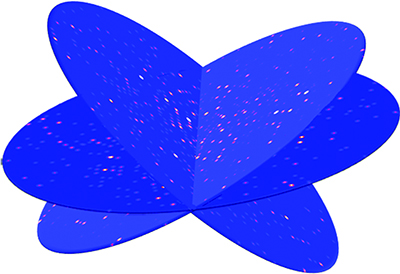Powder to become crystal clear

Turning one-dimensional diffraction from polycrystalline (powder) samples, particularly from multiphase samples, into three-dimensional single-crystal diffraction patterns has long been regarded as a difficult, if not impossible, task [Hao, Q. (2015). IUCrJ 2, 307-308; doi: 10.1107/S2052252515004017]. A group of scientists from China and the United States [Zhang et al. (2015). IUCrJ 2, 322-326; doi: 10.1107/S2052252515002146] have demonstrated that with the latest X-ray free-electron lasers (XFELs) and sample delivery technology, single-crystal diffraction patterns can be collected from multiphase polycrystalline samples and then the molecular structures can be solved ab initio.
The development of XFELs has opened up new opportunities for experiments that seem impossible now to become a reality in the near future. One of the new capabilities of XFELs is to collect single-crystal diffraction data from randomly oriented sub-micron-sized crystals using serial femtosecond crystallography (SFX).
Many materials with applications across many industries such as zeolites are polycrystalline (powders) and cannot be grown as single crystals. Furthermore, different types of samples (multiphase) may be mixed during production of a material; for example, zeolite NU-87 may occur as an impurity in zeolite TNU-9. X-ray diffraction from such samples will usually result in a one-dimensional powder pattern. Because of the relatively large molecular size, the powder diffraction pattern from a zeolite can be difficult to interpret. The powder diffraction pattern from a mixture of TNU-9 and NU-87 would be impossible to process.
Powder samples are essentially a mixture of sub-micron-sized single crystals. In this study Zhang et al. have proposed the use of serial crystallography to turn powder diffraction into single-crystal diffraction. A test has been performed on a mixture of zeolite using simulated diffraction patterns. X-ray diffraction snapshots by SFX were simulated and processed; identification according to the primitive unit-cell volume determined from individual snapshots was able to separate the whole set of snapshots in to two subsets, which matched the two zeolites in the sample. Monte Carlo integration was then applied to them separately. Two sets of three-dimensional single-crystal diffraction intensities could then be derived. The crystal structures of the two zeolites were solved using the direct methods program SHELXD with default parameters.
This technique promises to open up new avenues for the study of many important polycrystalline materials that cannot be analysed by conventional X-ray powder diffraction methods.


